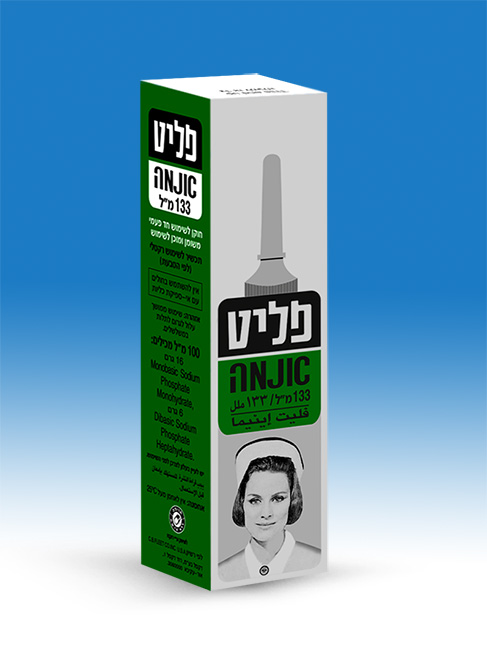Quest for the right Drug

פליט אנמה 133 FLEET ENEMA 133 (SODIUM PHOSPHATE)
תרופה במרשם
תרופה בסל
נרקוטיקה
ציטוטוקסיקה
צורת מתן:
רקטלי : RECTAL
צורת מינון:
חוקן : ENEMA
עלון לרופא
מינוניםPosology התוויות
Indications תופעות לוואי
Adverse reactions התוויות נגד
Contraindications אינטראקציות
Interactions מינון יתר
Overdose הריון/הנקה
Pregnancy & Lactation אוכלוסיות מיוחדות
Special populations תכונות פרמקולוגיות
Pharmacological properties מידע רוקחי
Pharmaceutical particulars אזהרת שימוש
Special Warning עלון לרופא
Physicians Leaflet
Special Warning : אזהרת שימוש
4.4 Special warnings and precautions for use Do not use Fleet Enema 133 when nausea, vomiting or abdominal pain is present unless directed by a physician. Patients should be advised to expect liquid stools and should be encouraged to drink clear liquids to help prevent dehydration, especially patients with conditions that may predispose to dehydration or those taking medications which may decrease glomerular filtration rate, such as diuretics, angiotensin converting enzyme inhibitors (ACE-Is, e.g. enalaparil, ramipril, lisinopril), angiotensin receptor blockers (ARBs, e.g. losartan, candesartan, eprosartan, irbesartan, olmesartan, telmisartan, valsartan) or non-steroidal anti-inflammatory drugs (NSAIDs). Since Fleet Enema 133 contains sodium phosphates, there is a risk of elevated serum levels of sodium and phosphate and decreased levels of calcium and potassium and consequently hypernatremia, hyperphosphatemia, hypocalcemia and hypokalemia may occur with clinical signs like tetany and renal failure. Electrolyte shifts are of particular concern in children with megacolon or any other condition where there is retention of enema solution, and in patients with co-morbidities. That is why Fleet Enema 133 should be used with caution in: elderly or debilitated patients and in patients with uncontrolled arterial hypertension, ascites, heart disease, rectal mucosal changes (ulcers, fissures), colostomy, patients who are taking diuretics or other medications which may affect electrolyte levels, who are taking medications known to prolong the QT interval (such as amiodarone, arsenic trioxide, astemizole, azithromycin, erythromycin, clarithromycin, chlorpromazine, cisapride, citalopram, domperidone, terfenadine, procainamide), or pre-existing electrolyte imbalance such as hypocalcaemia, hypokalaemia, hyperphosphataemia, hypernatraemia. Use also with caution in patients who are taking medications known to affect renal perfusion or function, or hydration status. Where electrolyte disorders are suspected and in patients who may experience hyperphosphataemia, electrolyte levels should be monitored before and after administration of Fleet Enema 133. The product should be used with caution in patients with impaired renal function, when the clinical benefit is expected to outweigh the risk of hyperphosphataemia. Repeated and prolonged use of Fleet enema 133 is not recommended as it may cause habituation. Administration of more than one enema in a 24 hour period can be harmful. Fleet Enema 133 should be administered according to the instructions for use and handling (see section 4.2). Patients should be warned to stop administration if resistance is encountered as forced administration of the enema may cause injury. Rectal bleeding after using Fleet Enema 133 may indicate a serious condition. If this occurs, administration must be discontinued immediately and the condition of the patient assessed by a physician. In general, evacuation occurs approximately 5 minutes after Fleet Enema 133 administration; therefore, retention times over 5 minutes are not recommended. If evacuation does not occur after using Fleet Enema 133 or if the retention time lasts for more than 10 minutes, serious side effects could occur. No further administrations should be given and the condition of the patient should be assessed by a physician who will decide if laboratory tests should be completed in order to detect possible electrolyte abnormalities and to minimize the risk of severe hyperphosphatemia (see sections 4.8 and 4.9). This medicine contains sodium benzoate which may cause local irritation. This medicine also contains sodium methyl parahydroxybenzoate and propyl parahydroxybenzoate which may cause allergic reactions (possibly delayed). Keep all medicines out of the sight and reach of children.
Effects on Driving
4.7 Effects on ability to drive and use machines Not relevant.

שימוש לפי פנקס קופ''ח כללית 1994
Laxative (hyperosmotic, saline), preparation for rectal examinations
תאריך הכללה מקורי בסל
01/01/1995
הגבלות
תרופה שאושרה לשימוש כללי בקופ'ח
מידע נוסף
